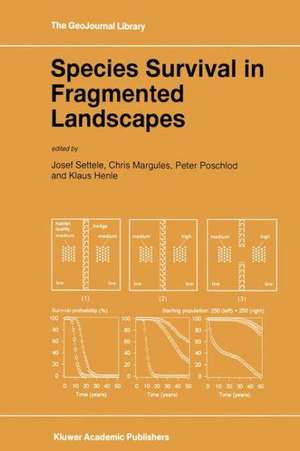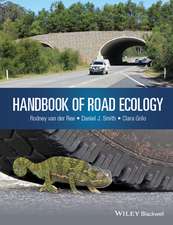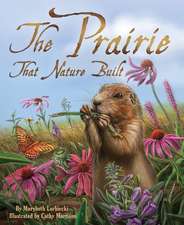Species Survival in Fragmented Landscapes: GeoJournal Library, cartea 35
Editat de J. Settele, Chris Margules, Peter Poschlod, Klaus Henleen Limba Engleză Paperback – oct 2011
| Toate formatele și edițiile | Preț | Express |
|---|---|---|
| Paperback (1) | 1221.83 lei 43-57 zile | |
| SPRINGER NETHERLANDS – oct 2011 | 1221.83 lei 43-57 zile | |
| Hardback (1) | 1227.99 lei 43-57 zile | |
| SPRINGER NETHERLANDS – 30 sep 1996 | 1227.99 lei 43-57 zile |
Din seria GeoJournal Library
- 15%
 Preț: 642.51 lei
Preț: 642.51 lei - 15%
 Preț: 632.70 lei
Preț: 632.70 lei -
 Preț: 396.78 lei
Preț: 396.78 lei - 18%
 Preț: 948.92 lei
Preț: 948.92 lei -
 Preț: 430.59 lei
Preț: 430.59 lei - 18%
 Preț: 899.69 lei
Preț: 899.69 lei - 15%
 Preț: 581.79 lei
Preț: 581.79 lei - 18%
 Preț: 938.34 lei
Preț: 938.34 lei - 18%
 Preț: 888.80 lei
Preț: 888.80 lei - 15%
 Preț: 703.85 lei
Preț: 703.85 lei - 18%
 Preț: 890.68 lei
Preț: 890.68 lei - 24%
 Preț: 777.65 lei
Preț: 777.65 lei -
 Preț: 400.65 lei
Preț: 400.65 lei - 18%
 Preț: 785.55 lei
Preț: 785.55 lei - 18%
 Preț: 946.55 lei
Preț: 946.55 lei - 15%
 Preț: 661.02 lei
Preț: 661.02 lei - 18%
 Preț: 945.79 lei
Preț: 945.79 lei - 15%
 Preț: 637.28 lei
Preț: 637.28 lei - 15%
 Preț: 637.59 lei
Preț: 637.59 lei - 15%
 Preț: 637.46 lei
Preț: 637.46 lei - 15%
 Preț: 635.31 lei
Preț: 635.31 lei - 20%
 Preț: 568.44 lei
Preț: 568.44 lei - 15%
 Preț: 645.79 lei
Preț: 645.79 lei - 20%
 Preț: 569.86 lei
Preț: 569.86 lei - 15%
 Preț: 651.99 lei
Preț: 651.99 lei - 15%
 Preț: 639.41 lei
Preț: 639.41 lei - 15%
 Preț: 643.48 lei
Preț: 643.48 lei - 15%
 Preț: 663.60 lei
Preț: 663.60 lei - 15%
 Preț: 651.99 lei
Preț: 651.99 lei - 15%
 Preț: 651.02 lei
Preț: 651.02 lei -
 Preț: 390.63 lei
Preț: 390.63 lei -
 Preț: 395.63 lei
Preț: 395.63 lei
Preț: 1221.83 lei
Preț vechi: 1490.03 lei
-18% Nou
Puncte Express: 1833
Preț estimativ în valută:
233.83€ • 243.22$ • 193.04£
233.83€ • 243.22$ • 193.04£
Carte tipărită la comandă
Livrare economică 14-28 aprilie
Preluare comenzi: 021 569.72.76
Specificații
ISBN-13: 9789401066402
ISBN-10: 940106640X
Pagini: 404
Ilustrații: XVI, 384 p.
Dimensiuni: 160 x 240 x 21 mm
Greutate: 0.56 kg
Ediția:Softcover reprint of the original 1st ed. 1996
Editura: SPRINGER NETHERLANDS
Colecția Springer
Seria GeoJournal Library
Locul publicării:Dordrecht, Netherlands
ISBN-10: 940106640X
Pagini: 404
Ilustrații: XVI, 384 p.
Dimensiuni: 160 x 240 x 21 mm
Greutate: 0.56 kg
Ediția:Softcover reprint of the original 1st ed. 1996
Editura: SPRINGER NETHERLANDS
Colecția Springer
Seria GeoJournal Library
Locul publicării:Dordrecht, Netherlands
Public țintă
ResearchCuprins
I Case Studies on Species Survival in Fragmented Landscapes.- The case for a science-based strategy of conserving threatened butterfly populations in the UK and north Europe.- Decline and rehabilitation of the Apollo butterfly Parnassius apollo (LINNAEUS, 1758) in the Pieniny National Park (Polish Carpathians).- Effects of habitat fragmentation on the butterfly Maculinea alcon in the Netherlands.- Forest resource management and the conservation of arboreal marsupials in Central Victoria, South-Eastern Australia.- The conservation biology of a specialist and generalist gecko in the fragmented landscape of the Western Australian wheatbelt.- Bird population dynamics in relation to habitat quality.- Population size, genetic variation, and related parameters in small, isolated plant populations: a case study.- Habitat networks in the fragmented landscape of the Western Australian wheatbelt: Preliminary results, involvement with landcare groups, and experience in implementation.- II A Reviewof Species Survival in Fragmented Habitats: Theory and Approaches.- Species survival and metapopulations: Conservation implications from ecological theory.- Genetical aspects of fragmented plant populations.- Applications of population viability analysis in conservation biology in Australia.- Area requirements and isolation: Conservation concepts and application in Central Europe.- Dispersal of plants in fragmented landscapes - Changes of dispersal processes in the actual and historical man-made landscape.- Experimental fragmentation.- Landscape fragmentation and landscape planning, with a focus on Germany.- III The FIFB Project.- FIFB: Conceptual frame.- Studying species survival in fragmented landscapes: the approach of the FIFB.- FIFB: the hilly landscape of Halle - main study area.- The Hilly landscape of Halle - main study area of the FIFB: Natural history and the selection of target species for conservation biological research.- Vegetation Cover of porphyry Outcrops.- Vegetationstructure of the porphyry Landscape of Halle.- Relations of invertebrate species to habitat Quality in the fragmented Porphyry Landscape near Halle (Sachsen-Anhalt, Germany).- Invertebrates and area size in the porphyry Landscape of Halle.- Invertebrates and Isolation in the porphyry Landscape of Halle.- FIFB: Survival of plants in fragmented landscapes.- Why are some plant species of fragmented continental dry grasslands frequent and some rare? - The role of germination and establishment.- Survival of small isolated populations of Muscari tenuifolium TAUSCH in dry continental Grasslands - The role of reproduction.- Restoration of fallow or afforested calcareous grasslands by clear-cutting.- A coenotical approach of plant population viability analysis on successional and afforested calcareous grassland sites - Towards an ecological flora data base.- FIFB: Survival of vertebrates in fragmented landscapes.- Survival of birds in fragmented landscapes.- Survival of lizards in habitat islands in Central Europe - Introduction and summary conclusions.- Survival of the sand lizard Lacerta agilis LINNAEUS, 1758 (Sauria, Lacertidae) in relation to habitat quality and heterogeneity.- Consolidation of vineyards, mitigations, and survival of the common wall lizard (Podarcis muralis) in isolated habitat fragments.- FIFB: Survival of butterflies in fragmented landscapes.- Research on population viability of Melitaea didyma (Lepidoptera, Nymphalidae).- A population ecological study of Chazara briseis (Lepidoptera, Satyrinae).- Aspects of the population vulnerability of the large blue butterfly, Glaucopsyche (Maculinea) arion, in South-West Germany.- Towards demographic population vulnerability categories of butterflies: Requirements of and species selection for future population ecological research.- FIFB: Survival of grasshoppers and bush crickets in fragmented landscapes.- The ecological background of population vulnerability in central European grasshoppers and bush crickets: Abrief review.- A population vulnerability analysis of the stripe-winged grasshopper, Stenobothrus lineatus (Caelifera: Acrididae).- A population vulnerability analysis of the red-winged grasshopper, Oedipoda germanica (Caelifera: Acrididae).- Elements of population vulnerability of the blue-winged grasshopper, Oedipoda caerulescens (Caelifera: Acrididae).- Population vulnerability of the grey bush cricket Platycleis albopunctata (GOEZE, 1778) (Ensifera: Tettigoniidae).- FIFB: Survival of snails in fragmented landscapes.- Survival of snails in fragmented landscapes.- FIFB: Genetics, habitat models, and implementation.- Genetics of insect populations in fragmented landscapes - A comparison of species and habitats.- Mapping and assessing habitat models on the landscape level.- Implementation of FIFB results in environmental planning.- IV Summary Conclusions.- Species survival in relation to habitat quality, size, and isolation: Summary conclusions and future directions.














